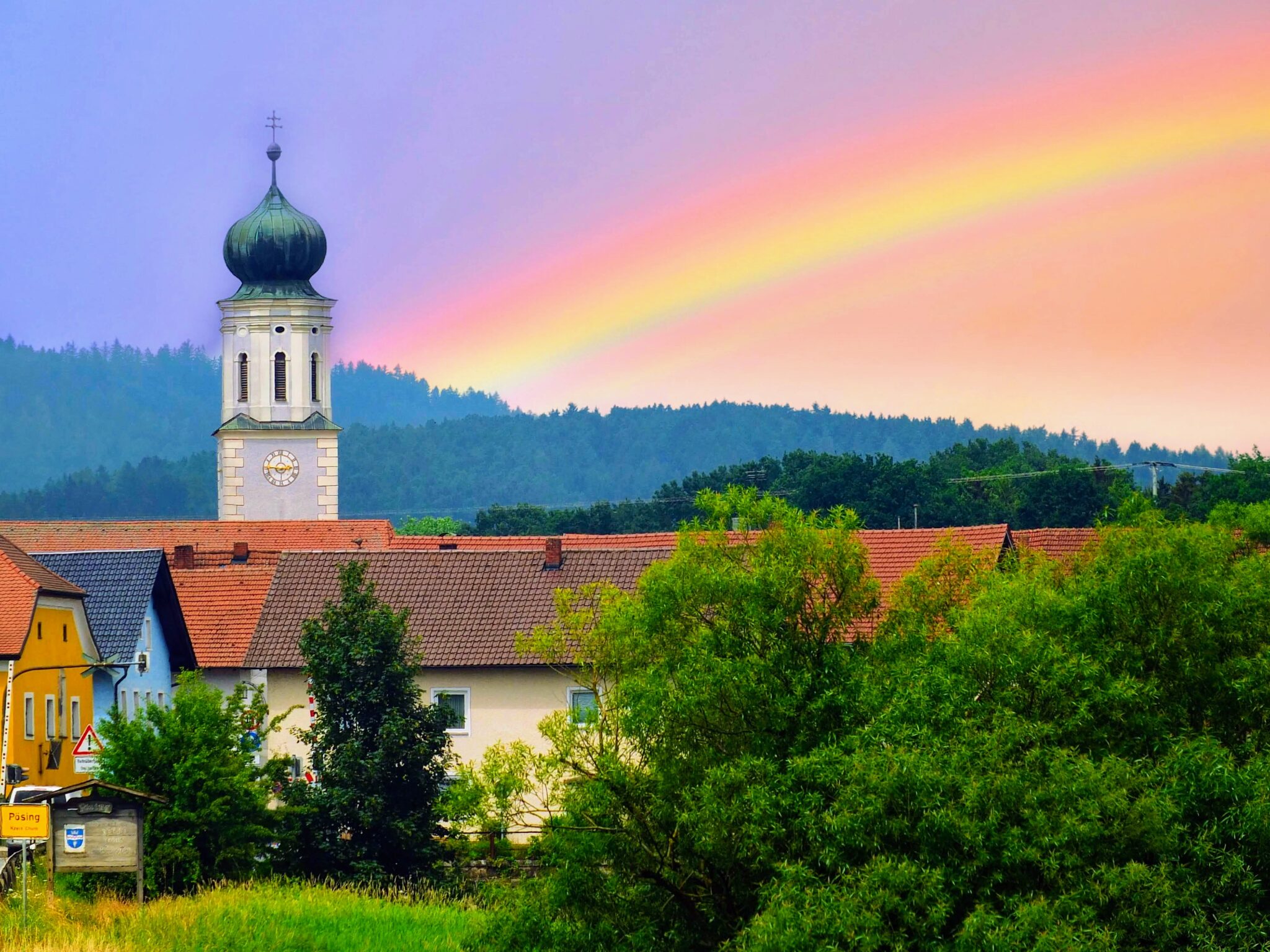
Hiking from Runding to Cham to Roding offers a great little slice of the Bavarian Forest and a chance to experience a bit of local beer culture. The route travels through a variety of landscapes, including forests, meadows, views of the open valley, and river views. “The Land of Rainbows” is a bit of an inside joke though — nobody really calls it that but me although I bet there are plenty of rainbows there. The local tourism tagline for the area is “Land der Regenbogen.” When I typed that into my trusty (maybe not so trusty) Google translator it returned the romantic-sounding “Land of Rainbows.” The lack of mention of rainbows anywhere along the way piqued my curiosity so I inquired. My inquiry befuddled the tourism folks. The meaning they put to the tagline is “Land of the Regen River.” It turned out to be one of those Google translate oddities.

The Regen in this area is a lazy, curling tributary of the Danube River which it joins near Regensburg. The headwaters of the Regen are in the low mountains of the Bohemian Forest along the Czech-German border. I started my hike in Runding, a village that can be reached by bus. The route drops into the valley and uses a mix of roadside pathways, farm tracks, forest paths, and riverside paths as it proceeds downriver to Roding. There are train stops at Cham, Posing, and outside of Roding so there are several options for breaking up the hike into segments.

Beer stops on the route are at the Schlossbrauerei Runding, the Rhaner Braustubl in Cham, Drexler Bräu in Posing, Brauerei Brantl in Roding, and Brauerei Greiner I timed the hike to end up at the Rodinger Volksfest where Dimpflbrau from nearby Furth I’m Wald was the beer on tap. These all seemed to me to be traditional breweries offering a traditional range of beers. I didn’t get out to the Rhaner brewery, but I would have liked to — they do regular tours and public events. I found it curious that neither of Roding’s local beers are served at the town’s Volksfest. That job is held by Dimpflbrau up the tracks in Furth. I’m told that Dimpflbrau specializes in festivals and events.
Breweries, beer stops, and beers mentioned in this article: Schlossbrauerei Runding – Rhaner Braustubl – Rhanerbrau – Drexler Bräu – Brauerei Brantl – Brauerei Greiner – Dimpflbräu Strauß
Cham (pronounced “came”) is a pretty town of about 35,000 people in the Bavarian Forest. It was an important trading center during the Middle Ages. It is home to a number of historical and cultural attractions, including the Cham Castle, the Old Town, and the Museum of the Upper Palatinate. Although no brewery has survived the ages in Cham, Rhanerbrau has a pub near the center and makes a tasty beer. Rhanerbräu is in a village called Schönthal in the countryside north of Cham and has been operated by the same family since 1776.

My off-the-cuff first impression of Cham was that it must be a Bavarian pirate town. There were life-sized pirate mannequins everytime I turned around. And another odd thing — I was there around noon and the French “Marseillaise” was playing in the town square from chimes in one of the towers. Curious. Inspecting the fountain in the square, there was a bronze pirate occasionally spoutin streams of water at people who passed too close. Evenyually I came to learn that these things had nothing to do with pirates — they are tributes to the town’s favorite son, Nikolaus Graf von Luckner. Although he was a German from Cham, Count Luckner joined the French army for some reason and became a top general serving in both the French and American Revolutionary Wars. After all of that, he ran afowl of the authotirities who came to power after the French Revolution during a period called the Reign of Terror and died at the guillotine in 1794.

The route departs Cham through the “Beer Gate” (Biertor in German), a remnant of the medieval wall that once ringed the town. Built in the 14th century, there was once an adjacent wheat beer brewery. It became known as Biertor due to its use as a place where taxes on beer being brought into town were collected.
The next waypoint was in the village of Posing where I stopped for a beer at Drexler Brau. The pub was closed when I came through, but I was able to purchase a beer off the dock to accompany my afternoon snack in the forest above Wetterfeld. In the forest, I came across a sobering historical reminder and memorial to the victims of a World War II-era murder of a group of 50 prisoners from Flossenberg Concentration Camp (65 km to the North). “Remember the dead in prayer.”

Roding seemed similar in size to Cham — at least the commercial center. Roding is home to two breweries — Brauerei Brantl and Brauerei Greiner. I made Roding my destination in order to visit the Rodinger Volksfest an annual event that is held for eleven days each summer. I’m a sucker for small town festivals like this. The people dust off and don their “trachten”. The festival grounds by the river were filled with tents and stalls selling traditional Bavarian food and drink, as well as games and rides. A single large tent hosted lines of tables surrounding a band playing beer-drinking music. Servers stayed busy doling out liter steins of festbier drawn from wooden barrels and delivering giant pretzels, half chickens, roast pork knuckles, and other prime traditional fare.
I did my best, then walked a bit faster to the train stop near Roding for a quiet ride back to my base in Bad Kotzting.
The Hike Through the Land of Rainbows
Rodinger Volksfest
Click here for more stories of beer hiking and travels in Bavaria































































































Leave a Reply